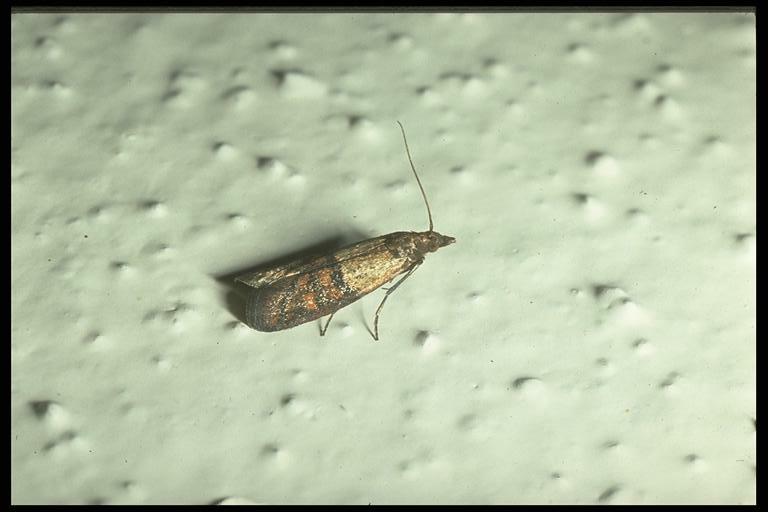
Indian meal moth, Plodia interpunctata Hübner (Lepidoptera: Pyralidae), adult. Photo by Drees.
Common Name: Indian meal moth
Scientific Name: Plodia interpunctata Hübner
Order: Lepidoptera
Description:Moths are 3/8 to 1/2-inch long with wings folded over the back. Wings are two-toned, with the bases a pale gray and the ends reddish brown or copper. Caterpillars are dirty white with brown heads. They grow to about 1/2-inch long and may become yellowish, pinkish, brownish or greenish.
Indian meal moths are often mistaken for clothes moths (Lepidoptera: Tineidae) when they are detected flying around in the home. The clothes moth does not have two-toned wings. Their wings are uniformly gray. Another stored grain infesting caterpillar species, the Angoumois grain moth, Sitotroga cerealella (Oliver) (Lepidoptera: Gelechiidae), infests seeds of corn, wheat, oats, sorghum, barley and other crops. Adult moths are small, all yellow moths with a 3/5 inch wingspan. Egg-laying females infested seeds either while crops are in the field or in storage. Larvae tunnel into seeds, feeding on the germ and endosperm, and form silk tubes in which they pupate. Their life cycle is completed in about 5 weeks and up to six generations can occur annually. Other major stored grain pests are rice weevils, Sitophilus oryzae (Linnaeus) and granary weevils, S. granarius (Linnaeus) (Coleoptera: Curculionidae).
Life Cycle: Night-active female moths lay eggs, singly or in clusters, on suitable larval food. Caterpillars hatch from eggs and produce silken tunnels for protection while feeding. Larval development varies in length with temperature and type of food material. Just before pupating, larvae leave the food source. Caterpillars can be found crawling on walls and ceilings searching for a place to spin a cocoon. Development from egg to adult takes from 27 to 305 days, and 7 or 8 generations can occur in a year.
Habitat and Food Source(s): Caterpillars have chewing mouthparts. Adults have siphoning mouths. Caterpillars feed in flour (including whole wheat and cornmeal or Indian meal)., shelled corn and other broken stored grains, dried fruit, seeds, crackers, biscuits, nuts, powdered milk, chocolate, candy, red peppers, and dog food. Caterpillars produce a loose silken mat on top surface of infested food material.
Pest Status: Moths are often found flying in kitchens and other rooms of the house, being a nuisance to occupants; appearance of moths is an indication of a breeding population of caterpillars in some type of stored food; medically harmless.
For additional information, contact your local Texas A&M AgriLife Extension Service agent or search for other state Extension offices.
Literature: Ebeling 1978; Little 1963.